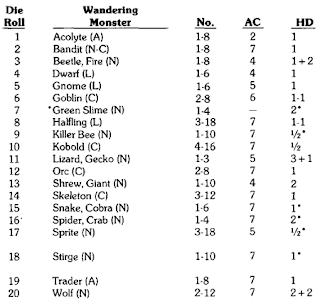Probably a Crazy Idea
 Among the most commonly forgotten and/or outright ignored rules in Dungeons & Dragons concerns wandering monsters. Once every 10 minutes of game time (in OD&D anyway; other editions of the game employ slightly different timescales), the referee rolls a six-sided die. A roll of 6 indicates that a wandering monster has appeared and one or more tables is consulted to determine their type and number. Even if one is not, as many contemporary referees seem to be, opposed to the idea of wandering monsters, it is very easy to let this rule fall by the wayside. I know this well, since it happens to be me regularly and has done since I first began to play D&D.
Among the most commonly forgotten and/or outright ignored rules in Dungeons & Dragons concerns wandering monsters. Once every 10 minutes of game time (in OD&D anyway; other editions of the game employ slightly different timescales), the referee rolls a six-sided die. A roll of 6 indicates that a wandering monster has appeared and one or more tables is consulted to determine their type and number. Even if one is not, as many contemporary referees seem to be, opposed to the idea of wandering monsters, it is very easy to let this rule fall by the wayside. I know this well, since it happens to be me regularly and has done since I first began to play D&D.I have a theory of why this is so. Unlike combat, each of whose rounds is played out individually, the 10-minute turn is much less directly concrete and the activities occurring during it are often abstracted rather than explicitly played out. As a result, turns "stick" less in the mind than combat rounds. This is compounded by the fact that often nothing of note happens during the course of a turn beyond simply advancing further down a passageway (and mapping it, of course). After enough turns of "nothing" happening, they tend to blend into each other and all but the most fastidious referee is going to lose track of in-game time.
This is why I propose rolling for wandering monsters once every 10 minutes (or whatever interval) of real time. This may seem radical, even nonsensical, but I think there's merit to the idea. For one, it's much easier (for me anyway) to consistently keep track of actual intervals of 10 minutes. Second, it's an additional incentive for the players to get things done. Over many years of refereeing, I have observed that players have a tendency to, as one of the players in my House of Worms campaign would say, faff about. However, given the limited time available for play, it behooves the players to stay focused on the matter at hand. The threat of a wandering monster roll every 10 real minutes might serve to light a fire under them, don't you think?
Obviously, this approach demands some degree of flexibility. For example, I wouldn't make a wandering monster roll in the middle of an active combat, even if the 10-minute mark had arrived. There are probably a handful of other circumstances where I'd be similarly inclined. However, the wandering monster rule exists, I suspect, as a pacing mechanism, as well as a potential drain of resources, which is why it's vital to ensure it's used rather than forgotten. If tying it to the real-world passage of time aids in this, I don't see an immediate problem in doing so (though I am sure my readers will find plenty of problems I've overlooked).
Published on December 08, 2022 09:19
No comments have been added yet.
James Maliszewski's Blog
- James Maliszewski's profile
- 3 followers
James Maliszewski isn't a Goodreads Author
(yet),
but they
do have a blog,
so here are some recent posts imported from
their feed.



